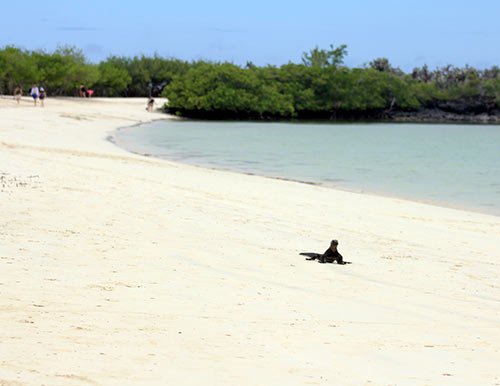Itinerary A
Kicker Rock
San Cristobal airport. Airport reception. Transfer to the ship. Galaxy II Cruise welcomes you. Lunch and welcome drink. Kicker Rock, or Leon Dormido (a pair of rocks that are approximately 148m high) is named by the similarity to a lion. We will travel between these two rocks.
Cerro Brujo
Brujo Hill, an eroding tuff cone that is made up of lava types a - a at some locations. The low-viscosity, gasless lava solidifies as it breaks and then is pushed forward by the lava flowing from behind.
Santa Fe Island
Activities for the day include hiking, snorkeling and swimming. This place is a centrally located island with a 24 km2 area and 60 meters above sea level. It has an amazing bay of turquoise waters protected by rocks. You can also see seals, hawks and other birds flying overhead. The island is the home to one of two land iguana species that inhabit the islands. Their main diet consists of leaves and fruit of the thick and large cactus. The Bay is home to a variety of animals, including crabs, herons at night, marine iguanas (including the marine iguana), cucuves, and landdoves. It is a great place for swimming and snorkeling. Attractions like marine tortoises, rays or sea lions as well as tropical fishes can be amazing! On board, you can expect to find snacks and drinks that are refreshing. Lunch.
South Plaza Island
South Plazas is a pair of small islands created by uplifted land where land iguanas nest in warm weather. This hike takes you along a cliff that is home to seabirds. On this island, there are approximately 1000 sea lions.
North Seymour Island
The lifting of marine volcanic lava formed this island. This island has marine fossils dating back to the Pleistocene. The Capitan Alan Hancock, his crew and 72 land iguanas moved from Baltra Island to North Seymour Island in 1932. This was done because the iguanas would be able to live better than on Baltra. Capitan Hancock's crew found malnourished land iguanas on Baltra. In 1934, colonizing people confirmed that they were healthy. North Seymour has a dense vegetation and is home to nests of Real Frigates Galapagos. EcoGalaxy. Lunch
Mosquera Islet
The islet lies between North Seymour and Baltra Island. This islet has the largest sea lion colony. It's also possible to see several bird species.
Darwin Bay
Activities for today: photography, short walks, swimming and snorkeling. Our landing in Darwin Bay will take place on the Genovesa, a small isle located north of Galapagos. We will visit a mangrove forest near the beach where you will see a Frigate colony, a marine iguana, red-footed boobies or mask boobies as well as the Great Terrestrial Finch, a seagull and herons. We can let our guests swim in the bay after this land visit. After lunch, we can take our passengers swimming in the bay.
El Barranco
Hiking is a good activity for dry landing. Also called Prince Felipe’s steps. We will walk along the Barranco Path. On our trip, we'll see tropical birds such as petrels and common frigates, plus red-footed boobies (also known as mask boobies), doves, finches, and more.
Punta Carrion, located northeast of Santa Cruz will be our destination. We will sail around the point to give you the opportunity to view various seabirds nesting in rock cliffs.
Transfer out.

Highlights
- Galapagos sea lions, marine Iguanas, magnificent & great frigatebirds, blue-footed Boobies, San Cristobal Lava Lizards.
- Giant tortoises, Darwin finches, barn owls, white-cheeked pintails, Galapagos flycatchers, Lava tunnels.
- Nesting great frigatebirds, red footed & Nazca boobies, Galapagos sea lions, lava & swallow-tailed gulls, yellow-crown night herons, Genovesa ground finch, Genovesa cactus finch, Galapagos mockingbirds.